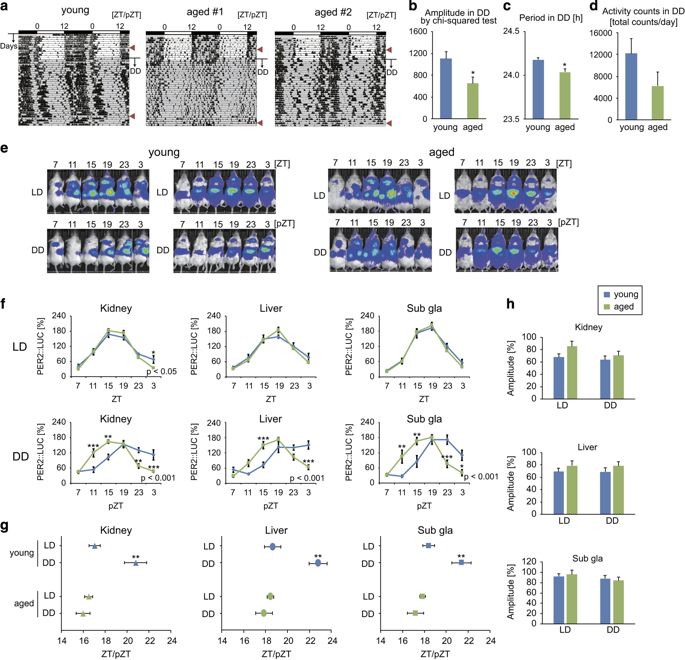npj Aging and Mechanisms of Disease Pub Date : 2017-01-05 , DOI: 10.1038/npjamd.2016.30 Yu Tahara , Yuta Takatsu , Takuya Shiraishi , Yosuke Kikuchi , Mayu Yamazaki , Hiroaki Motohashi , Aya Muto , Hiroyuki Sasaki , Atsushi Haraguchi , Daisuke Kuriki , Takahiro J Nakamura , Shigenobu Shibata

|
The ability of the circadian clock to adapt to environmental changes is critical for maintaining homeostasis, preventing disease, and limiting the detrimental effects of aging. To date, little is known about age-related changes in the entrainment of peripheral clocks to external cues. We therefore evaluated the ability of the peripheral clocks of the kidney, liver, and submandibular gland to be entrained by external stimuli including light, food, stress, and exercise in young versus aged mice using in vivo bioluminescence monitoring. Despite a decline in locomotor activity, peripheral clocks in aged mice exhibited normal oscillation amplitudes under light–dark, constant darkness, and simulated jet lag conditions, with some abnormal phase alterations. However, age-related impairments were observed in peripheral clock entrainment to stress and exercise stimuli. Conversely, age-related enhancements were observed in peripheral clock entrainment to food stimuli and in the display of food anticipatory behaviors. Finally, we evaluated the hypothesis that deficits in sympathetic input from the central clock located in the suprachiasmatic nucleus of the hypothalamus were in part responsible for age-related differences in the entrainment. Aged animals showed an attenuated entrainment response to noradrenergic stimulation as well as decreased adrenergic receptor mRNA expression in target peripheral organs. Taken together, the present findings indicate that age-related circadian disorganization in entrainment to light, stress, and exercise is due to sympathetic dysfunctions in peripheral organs, while meal timing produces effective entrainment of aged peripheral circadian clocks.
中文翻译:

外周时钟调节中由交感神经功能障碍引起的与年龄有关的昼夜节律紊乱
昼夜节律时钟适应环境变化的能力对于维持体内平衡,预防疾病和限制衰老的有害影响至关重要。迄今为止,关于外围时钟夹带外部线索的年龄相关变化知之甚少。因此,我们评估了在体内使用幼鼠和老年鼠的外部刺激(包括光照,食物,压力和运动)对肾脏,肝脏和下颌下腺的外周钟带动的能力。生物发光监测。尽管运动能力下降,但在明暗,恒定黑暗和模拟时差条件下,老年小鼠的外围时钟仍显示出正常的振荡幅度,但相位发生了一些异常变化。但是,在与压力和运动刺激有关的外周时钟夹带中观察到了与年龄有关的损伤。相反,在与食物刺激有关的外围时钟夹带和食物预期行为的表现中观察到与年龄有关的增强。最后,我们评估了以下假设:位于下丘脑上视交叉上核的中央时钟的交感神经输入不足,部分原因是年龄相关的夹带差异。老年动物在目标周围器官中表现出对去甲肾上腺素能刺激的减弱的夹带反应以及降低的肾上腺素能受体mRNA表达。综上所述,目前的发现表明,与年龄相关的昼夜节律紊乱是由于对周围器官的交感神经功能障碍造成的,而进餐时间则产生了对老年的外周昼夜节律的有效夹带。


























 京公网安备 11010802027423号
京公网安备 11010802027423号